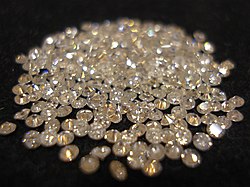Jewellery

Jewellery (or jewelry) refers to any clothing accessory that is worn as a decoration.
In itself, jewellery has no other purpose than to look attractive. However, it is often added to items that have a practical use. Items such as belts and handbags are mainly accessories but may be decorated. A broach, often worn to keep a cloak closed, could be highly decorated with jewels.
Necklaces, finger rings and earrings are the most usual kinds of jewellery.
History
Humans have made jewellery for a long time. There are many forms of jewelry worn for traditional, social or religious reasons. Jewellery can come in many forms, worn on any part of the body or clothing. Jewellery most often are rings, chains, bead strings, pendants and piercings, worn around or on different body parts.
Creation
Jewellery can be made from any material. The first jewellery was made from bone, animal teeth, wood or stone. Jewelry often uses gemstones and precious metals.
Fashion jewellery or costume jewellery is jewellery that is worn just for fashion, and is not made of expensive materials.
Common jewellery types
- Earrings, which is any jewellery worn on the ears
- Necklaces, worn around the neck
- Finger rings and toe rings (finger rings are usually just called "rings")
- Bracelets or bangles, worn on the wrists
- Arm rings or armlets, worn on the upper arms
- Pins or brooches, worn on clothes for decoration or keeping clothes from undoing.
- Piercings, which is jewelry that is put through holes in the skin
- Cremation jewelry such as keepsakes, bracelets, keychains, necklaces, pendants or rings
Gallery
A Kenyan man wearing tribal bead necklaces.
Pendants made of amber.
Bohemia, 14th century jewelled clasp with eagle motif
Spanish emerald and gold pendant at Victoria and Albert Museum.
Royal earrings, India, 1st Century BC.
Jewellery Media
Hair ornament, an Art Nouveau masterpiece; by René Lalique; c. 1902; gold, emeralds and diamonds; Musée d'Orsay (Paris)
Oldest golden artifacts in the world from Varna necropolis – grave offerings on exposition in Varna Museum
Headdress decorated with golden leaves; 2600–2400 BC; gold, lapis lazuli and carnelian; length: 38.5 centimetres (15.2 in); from the Royal Cemetery at Ur; Metropolitan Museum of Art (New York City)
Byzantine collier; late 6th–7th century; gold, emeralds, sapphires, amethysts and pearls; diameter: 23 centimetres (9.1 in); from a Constantinopolitan workshop; Antikensammlung Berlin (Berlin, Germany)
Cameo; 16th century; sardonyx; Cabinet des Médailles (Paris)
Related pages
References
| Wikimedia Commons has media related to Lua error in Module:Commons_link at line 62: attempt to index field 'wikibase' (a nil value).. |

















